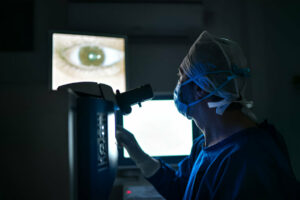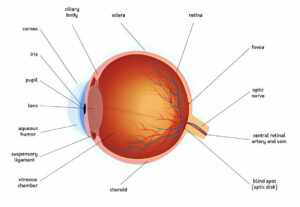
Cataract surgery is typically conducted as an outpatient process and you should expect to spend around 30 minutes at the treatment area.
Before beginning, your doctor will administer eye drops or an injection to numb the area in question and may also provide you with a sedative should the procedure cause anxiety.
Your doctor will perform cataract surgery by extracting and replacing your cloudy lens with an artificial intraocular lens (IOL), which allows light to focus properly onto the retina, correcting blurry vision.
1. The Anesthesia
At cataract surgery, patients are administered local anesthetics to block pain signals from reaching the brain at the surgical site. Depending on individual patients, additional medications may also be given in order to relax or sleep during surgery, including sedatives, muscle relaxants and potentially even combinations of narcotic painkiller, acetaminophen and oxycodone. For some surgeries or conditions that warrant it, general anesthesia will also be administered.
Cataract surgery is an efficient and safe solution to restore vision after age-related lens changes have altered vision. Common symptoms include blurry vision, light sensitivity, increased glare, faded color vision and difficulty driving at night, which makes everyday tasks like cooking or reading increasingly challenging. For these reasons alone many opt to have their cataracts extracted.
Your doctor will first make a tiny incision in your eye and insert a probe that uses ultrasound waves to break up and suction out the cataract. Next, they will insert an artificial intraocular lens (IOL) into the “capsular bag” that held your natural lens so light can pass through and focus directly onto your retina for clearer vision.
Patients may experience some temporary discomfort following surgery, which should gradually subside over time. It is vital that eyes do not experience any irritation during this recovery period – no rubbing, no exertion of pressure on them; patients should wear protective shields while sleeping for added peace of mind and the doctor may prescribe eye drops to reduce inflammation and control eye pressure.
Patients typically return home on the same day after having cataract surgery; however, as they will not be able to drive themselves they must arrange for transportation and assistance with daily activities. They should also plan for at least a week at home and ensure they get enough rest; it is wise to avoid bending over or lifting heavy objects as this could put too much strain on their eye.
2. The Procedure
Cataract surgery is generally an uncomplicated surgical process performed on one eye at a time. You will typically leave the hospital after your procedure with protective covering over your eye for protection; you will require someone else to drive you home as well as assist with around-the-house activities and ensure the covering remains in tact at all times.
Initial eye drops will dilate your pupil so the surgeon can access your lens for removal. With ultrasound energy (phacoemulsification), natural cataracts are broken apart into pieces before being suctioned out from your eye, leaving a new artificial lens installed into your eye – this could either allow near and distance vision, or may eliminate glasses altogether.
Once your surgery has taken place, you will spend some time recuperating in the recovery room. Follow all instructions when using prescribed eye drops and keep sleeping eyes covered by shield.
Your vision may become temporarily clouded following cataract surgery, and this is perfectly normal. Additionally, there may be temporary glare and halos around lights as you adjust to your new lens. Your doctor will see you the day or two following surgery, then again within one week and again one month later to check on healing progress.
Sometimes your cataract may recur due to posterior capsular opacification (PCO), an increase in thickness in the capsule that surrounds and supports your lens. This condition can be treated through an effortless laser procedure known as yttrium aluminum garnet laser capsulotomy that works quickly and painlessly.
Be mindful that much of the eye pain you experience after cataract surgery may not be caused by physical discomfort but by emotional stress and anxiety related to it, leading to sympathetic stimulation resulting in tachycardia, hypertension, cardiac ischaemia and other symptoms. A standardised questionnaire has revealed a correlation between preoperative anxiety levels and postoperative eye pain levels.
3. The Recovery
Once the procedure is over, your surgeon will ask that you rest for approximately 30 minutes to allow them to plan the necessary follow-up appointments and give eye drops to reduce swelling and infection risk. Some drops may cause temporary gritty sensation in your eyes but this should pass within several days as will your vision improvement.
Your doctor will utilize an ultrasound device to measure the shape and size of your eye to help select an implant lens suitable for you. Most patients opt for intraocular lenses (IOLs), artificial lenses that replace your natural lens and direct light onto the retina – these lenses can correct nearsightedness, farsightedness and astigmatism.
An IOL is surgically placed through a small incision on the front of each eye using an injector tool by a surgeon, after which time an eye shield will be put over it for protection during recovery – most patients can resume most normal activities within 24 hours post surgery.
While recovering from cataract surgery, you should ensure to rest and avoid rubbing the eye. Furthermore, wearing an eye shield while sleeping will help protect you against accidental injuries as well as dirty water or soap entering the eye. Having someone nearby during recovery may help remind you to keep the shield on and not rub the eye; additionally heavy lifting or excessive bending may strain your eyes further.
Recovering from cataract surgery often causes some pain and itching, though these should pass within days. Make sure to notify your physician of these side effects as well as to follow any instructions for using eye drops correctly. If you experience difficulties seeing, schedule an appointment immediately with an eye doctor in order to evaluate healing progress and address any potential issues that may arise.
4. The Vision
Cataract surgery restores clear vision and can help you resume daily activities more easily. If symptoms such as blurred vision, light sensitivity, faded color vision or difficulty driving are interfering with your daily activities and making tasks such as driving difficult for you at work or home, cataract surgery may provide the answer.
Cataract surgery is a painless and quick procedure performed by eye doctors that involves replacing the natural lens in an eye with an artificial one. The procedure typically lasts less than 15 minutes. Before beginning, your eye doctor will dilate your eyes using eye drops; after making an incision in your cornea and breaking up the cataract into smaller pieces with ultrasound technology; they then suction away. Finally, after installing an artificial lens made of silicone, plastic or acrylic the wound will close naturally before you are sent home with protective shield for your eye.
Your ophthalmologist will provide instructions on post-surgical care. They will advise when it is safe for you to resume driving and resume normal activities, including sleeping without wearing protective shields that could accidentally rub or bump the eye during sleep. Your doctor may prescribe eye drops that assist healing while controlling inflammation and infection.
After cataract surgery, your vision may be slightly blurry or sensitive to light for several days following. This is normal and should improve over time as the incision heals. Blurry vision may also occur while healing takes place.
Although uncommon, cataract complications can include thickening of the capsule that holds your lens in place – known as posterior capsule opacification or PCO for short. This condition leads to cloudy vision in dim lighting or bright sunlight and makes it hard for you to see in dimly lit environments or under bright sunrays. A doctor may use painless laser treatment called yttrium aluminum garnet (YAG) laser capsulotomy to treat PCO, by placing a laser beam directly in your eye and using it create a hole which lets in light through.














